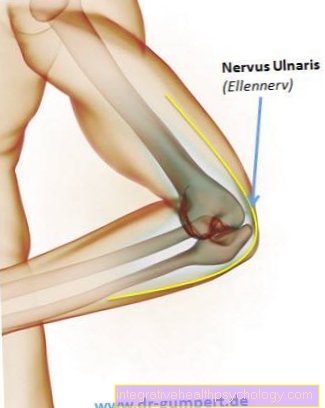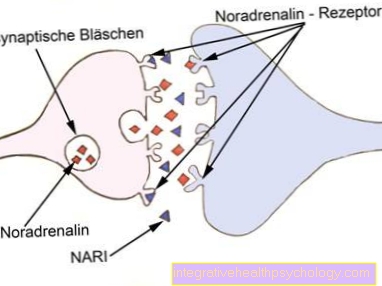Flatulence while breastfeeding
introduction
If flatulence is a common symptom of a woman during pregnancy, excessive gas formation in the intestine can persist or recur even during breastfeeding. This is very individual and justified by numerous possible foods as the cause. It is important to find out how well individual foods are tolerated and how they affect your body. This is best done by carefully recording the food consumed and by deliberately omitting or replacing certain products in order to assess the effect on digestion during breastfeeding.
You might also be interested in: Diet while breastfeeding

Why do I get gas while breastfeeding?
While the more frequent flatulence during pregnancy may be due to the hormone progesterone, there is currently no generally applicable explanation for flatulence during breastfeeding. It can therefore be assumed that hormonal changes during breastfeeding and exhaustion with the gradual recovery of the female body after pregnancy and childbirth can lead to flatulence.
Read more on the topic: Woman's hormones
Decreased exercise while breastfeeding can affect the maternal digestive tract. A lack of exercise makes digestion slower and food components stay longer in the intestine. This leads to increased gas formation. In addition, the birth of the child and the new demands on everyday life can represent a stressful situation that can also lead to flatulence for psychological reasons.
Many women take iron supplements while breastfeeding to treat their anemia. These drugs also often cause indigestion and gas. In addition, gas can also be caused by food during breastfeeding. This can even affect the consumption of food that previously did not cause digestive problems. The examples of flatulent foods are covered in the next section.
Furthermore, food intolerances can appear at any point in life or their symptoms can worsen. Therefore, if the symptoms persist, in spite of the modification of the meal, further diagnostics can occasionally be useful even during breastfeeding. Flatulence in the context of intolerance can occur, for example, with lactose and fructose intolerance. Increased gas formation also often occurs in the context of gluten intolerance. Often the flatulence in intolerance is associated with diarrhea.
Read more on the topic: Diet for people with lactose intolerance
What can I do with flatulence while breastfeeding?
The most effective measure of gas prevention is to carefully consider your eating plan. In doing so, possible triggers for increased gas formation in your own meal plan should be tracked down and avoided through temporary omission.
In addition, one should keep in mind that drinks can also be a possible cause of flatulence, especially if they contain carbonic acid. Even lemonades in the light version can have a flatulence due to the sugar substitutes they contain.
In addition, smaller meals that are regularly consumed throughout the day can be more digestible than the infrequent consumption of food in large quantities. In addition, care should be taken to chew thoroughly and, if possible, not speak while eating in order to avoid unnecessary air swallowing.
If there is already flatulence, various herbs and spices can help. Caraway seeds, fennel and anise are known to help, have a puffing and relaxing effect. They can be consumed in the form of herbal infusions or teas. In addition, fennel in particular can also be used in cooking and thus increase the digestibility of the food.
More information can be found here: Budget remedies for flatulence
Exercise can also help to release the gases faster, relax the intestines, and prevent gas. In addition, massages of the abdomen with circular movements can have a relaxing effect.
Warmth can also be helpful in the form of cherry stone pillows or hot water bottles. In addition, it is important to allow gas to escape in the case of flatulence and not to hold it convulsively, as this can worsen the symptoms and the stomach can become painful.
What foods cause gas?
There are numerous foods that have bloating properties in general, and not just for the period of breastfeeding. In addition, there are strong individual deviations, so that, for example, onions, which usually have a high potential for bloating, lead to weak intestinal gas formation in some people. Conversely, however, other foods that are not or only rarely associated with an increased incidence of flatulence can lead to flatulence.
A diet that contains a high proportion of carbohydrates is associated with a greater risk of flatulence, whereas proteins and fats have a lower gas-forming potential. This is due to the properties of fiber, which is a part of carbohydrates. These are indigestible for the human organism, which is why they bind water in the intestine and thus increase the volume of the stool. They have numerous valuable properties that are important for health, but can, as a side effect, contribute to the increased formation of intestinal gases.
Read more on the topic: Diet while breastfeeding
Examples of high-fiber vegetables include:
- cauliflower
- Broccoli
- sauerkraut
- Kohlrabi
- Onions
- garlic
- Legumes (e.g. beans, chickpeas and lentils)
Whole grain products are also high in fiber. Many types of fruit can also cause intestinal gas formation, whereby at this point we should once again point out the individual range of effects on the digestive tract of each person. Furthermore, milk products containing lactose can lead to flatulence in some people, especially if they are lactose intolerant and this is not yet known. Other intolerances can also cause symptoms depending on the food components that are not tolerated.
More information can be found here: Food intolerance
In addition, flatulence can occur more frequently if more light products are consumed or cooked with sugar substitutes. These include sorbitol and xylitol, which when taken frequently and used in larger quantities have laxative properties and can cause flatulence.
Read more on this topic at: Behavior during breastfeeding
Chocolate During Breastfeeding Causes Flatulence - Myth or Reality?
In the vast majority of cases, chocolate alone is not one of the classic flatulent foods, not even when breastfeeding. However, this applies to moderate consumption and also depends on the type of chocolate. If a lot of chocolate is eaten and if it contains a lot of sugar, the sugar interferes with digestion and increased gas formation can occur.
This can also be the case if the chocolate is a diet product. The use of sugar substitutes in light products can have a laxative and flatulence effect when large amounts are consumed. Any nuts that may be found in the chocolate can also lead to flatulence. It is therefore advisable to reduce consumption or to try other products if you suspect bloating caused by chocolate.
Flatulence from magnesium
When it comes to magnesium, the body's response to larger amounts consumed varies greatly, and not just during breastfeeding. The increased intake of magnesium via dietary supplements can lead to gastrointestinal problems as a side effect, including flatulence. On the other hand, however, magnesium plays an important role as a salt in homeopathy and is sometimes used there for flatulence and other gastrointestinal complaints. As with all foods or their components, it is therefore advisable to carefully check your body's own reaction.
Flatulence from asparagus
When it comes to asparagus, there are different views in the literature as to whether the vegetable can cause gas or not. Therefore, it should be checked in each individual case how your own body reacts to eating asparagus and how digestible it is. The fact is that asparagus is very healthy due to its high water content and numerous vitamins. It contains a lot of folic acid, which is very important for the child, especially during pregnancy and breastfeeding. If consumption leads to gas, it is advisable to eliminate asparagus from your diet. The body may react less sensitively to the consumption at a later point in time.
Flatulence from peppers
Although paprika is a very healthy vegetable, some people complain of increased gas formation in the gastrointestinal tract after consumption, even while breastfeeding, which is manifested by increased belching or flatulence. It can be helpful to try out the different types of peppers in different colors, as green peppers may cause more symptoms than ripe red peppers due to their lower degree of ripeness. In addition, it can be worthwhile to forego raw peppers and instead try them as a steamed, fried or baked variant. Many types of vegetables are easier to digest after they have been heated. Due to the higher vitamin C and acid content in peppers, it should be ensured that the infant reacts sensitively to the mother's consumption of peppers with a sore diaper area. Then paprika and similar acidic foods should be avoided while breastfeeding.
Flatulence from onions
Onions have potentially flatulent properties, which is not only true of the period of breastfeeding. As with all other foods, however, each body reacts differently. Therefore, onions can cause massive discomfort in some breastfeeding women, but other women can tolerate the healthy vegetable very well.
As with all possible triggers of flatulence, it is advisable to evaluate the effects of food intake on your own body. If the effects after eating are too serious and bothersome, it is advisable to try to skip it and, if necessary, to integrate onions into the daily meal plan again at a later point in time.
Does carbon dioxide play a role?
In the case of carbonated beverages, CO2 is kept dissolved in the water by the pressure in the beverage bottles, but begins to escape when the bottle is opened. It takes some time for the gas to escape, so that the process of gas formation continues in the digestive system when you drink. This creates an increased accumulation of gas, which can manifest itself after drinking carbonated drinks as increased belching or gas.
This can affect anyone and is not limited to the period of breastfeeding.If you react to carbon dioxide in beverages with unpleasant gas formation, they should either be drunk in an already slightly stale state and thus with a reduced amount of gas or still beverages should be preferred.
Do flatulent foods cause colic in children by their influence on breast milk?
For many years, breastfeeding women have been advised to follow a strict nutrition plan so as not to cause discomfort in the child from certain foods. These views persist to this day.
The fact is, however, that, according to current knowledge, there is no general need to avoid certain foods while breastfeeding in order to prevent childhood gas. Food that is often flatulent can lead to gas formation in the mother, but generally not in the child. However, some babies may be more individually sensitive, so it may be worthwhile for the mother to review their diet.
Read more on the topic: Flatulence in the baby and Homeopathy for colic in babies
However, it should not be avoided prophylactically on potentially flatulent foods. This can also be problematic, as a very restrictive diet for the mother can lead to a one-sided supply of nutrients and thus affect the quality of breast milk. A check of your own digestibility and the effects on the child is therefore much more useful than avoiding it as a preventive measure.
You might also be interested in: Diet while breastfeeding
This also applies to the possible association of some foods with a sore diaper area. Some fruit and vegetables that contain acid can lead to reddening of the buttocks in the infant when consumed by the mother. If such symptoms occur, the causative foods should be avoided for the period of breastfeeding.
You will find more information on this topic here: Problems in the child during breastfeeding





























